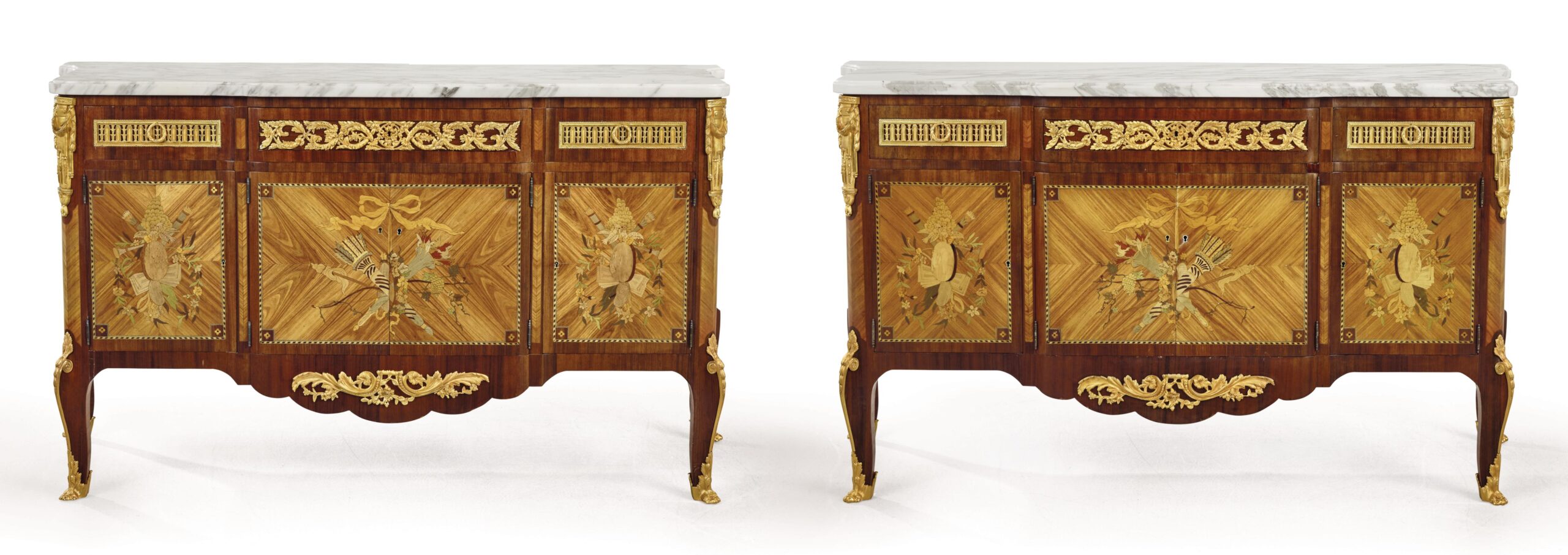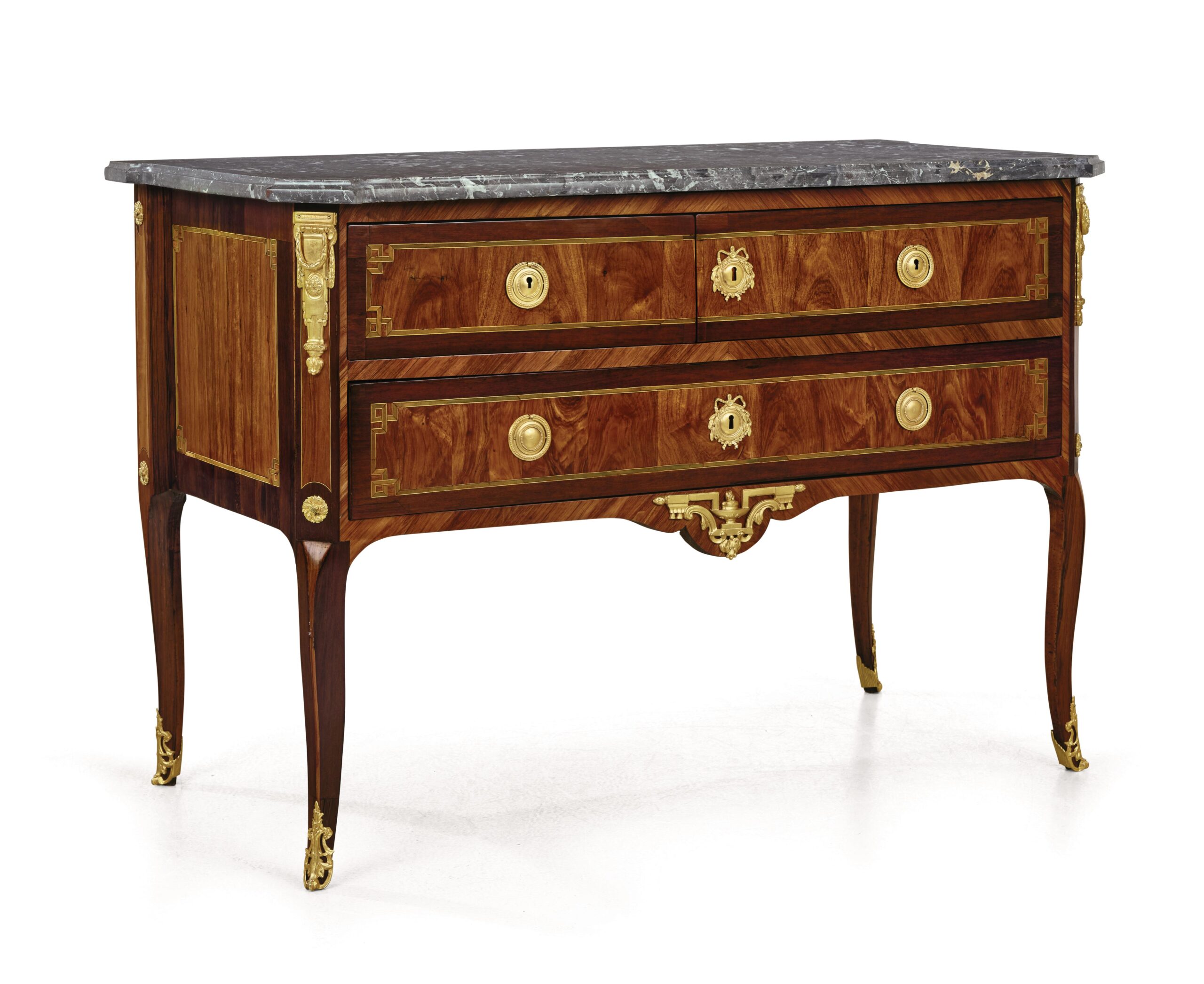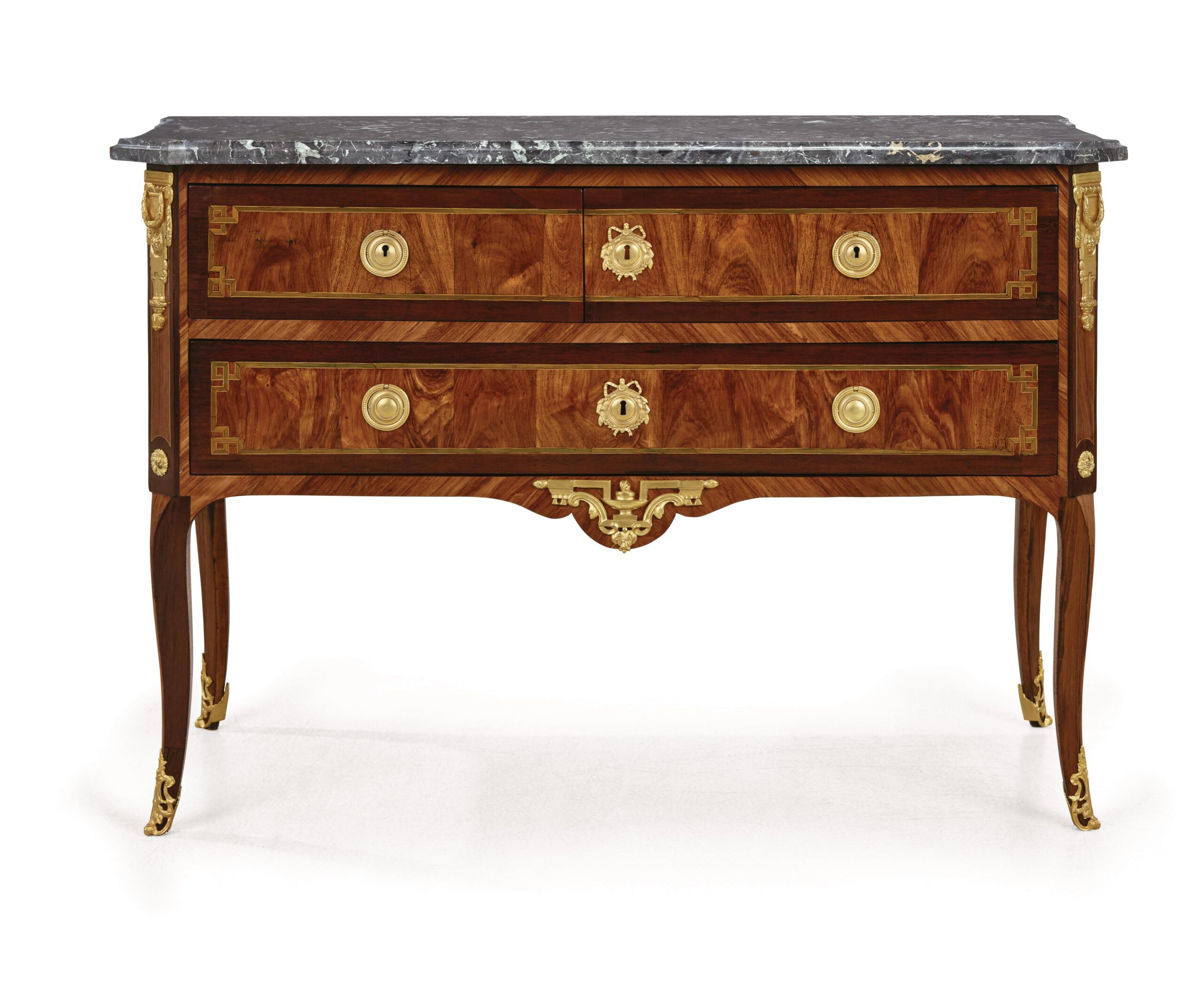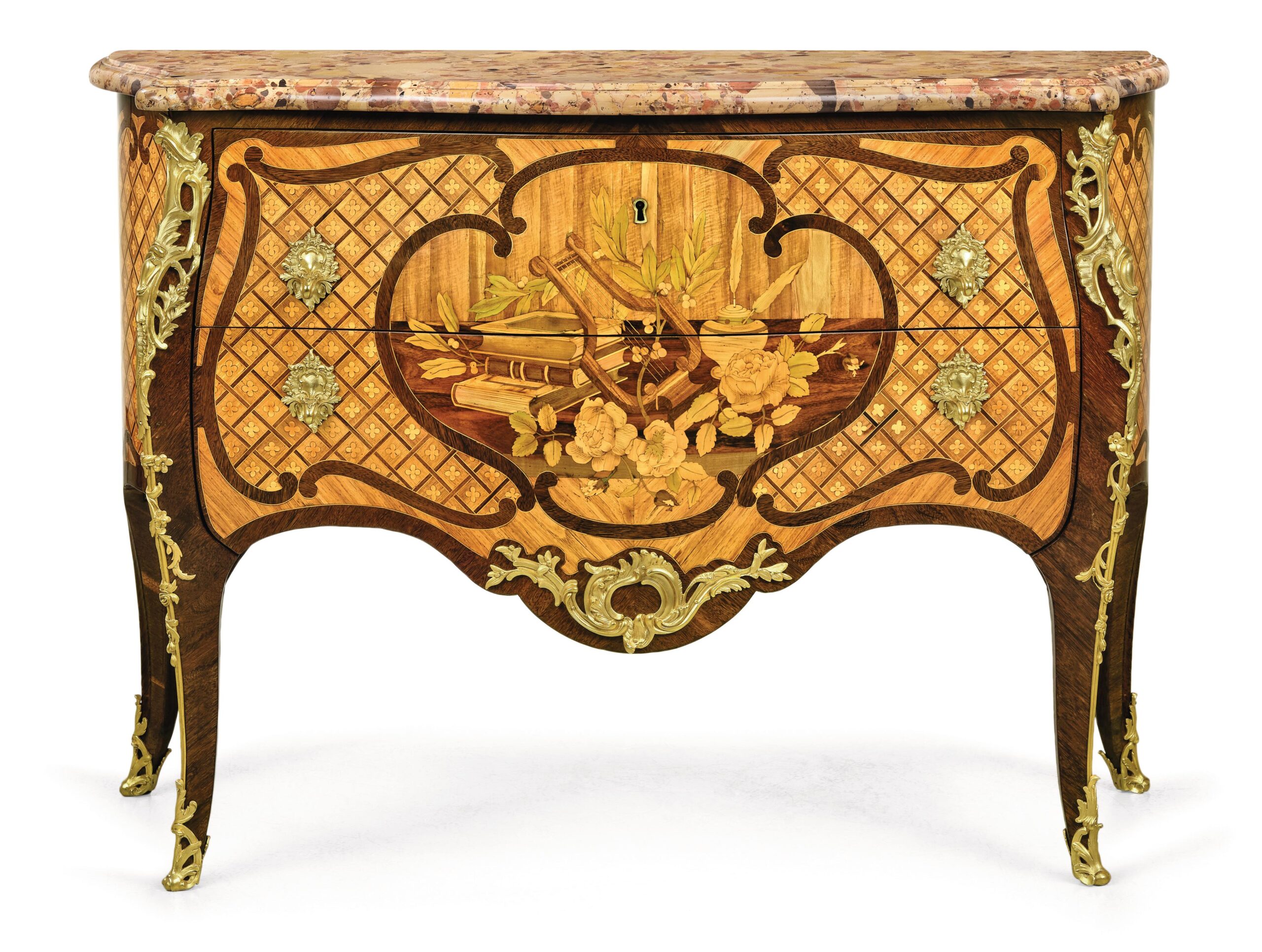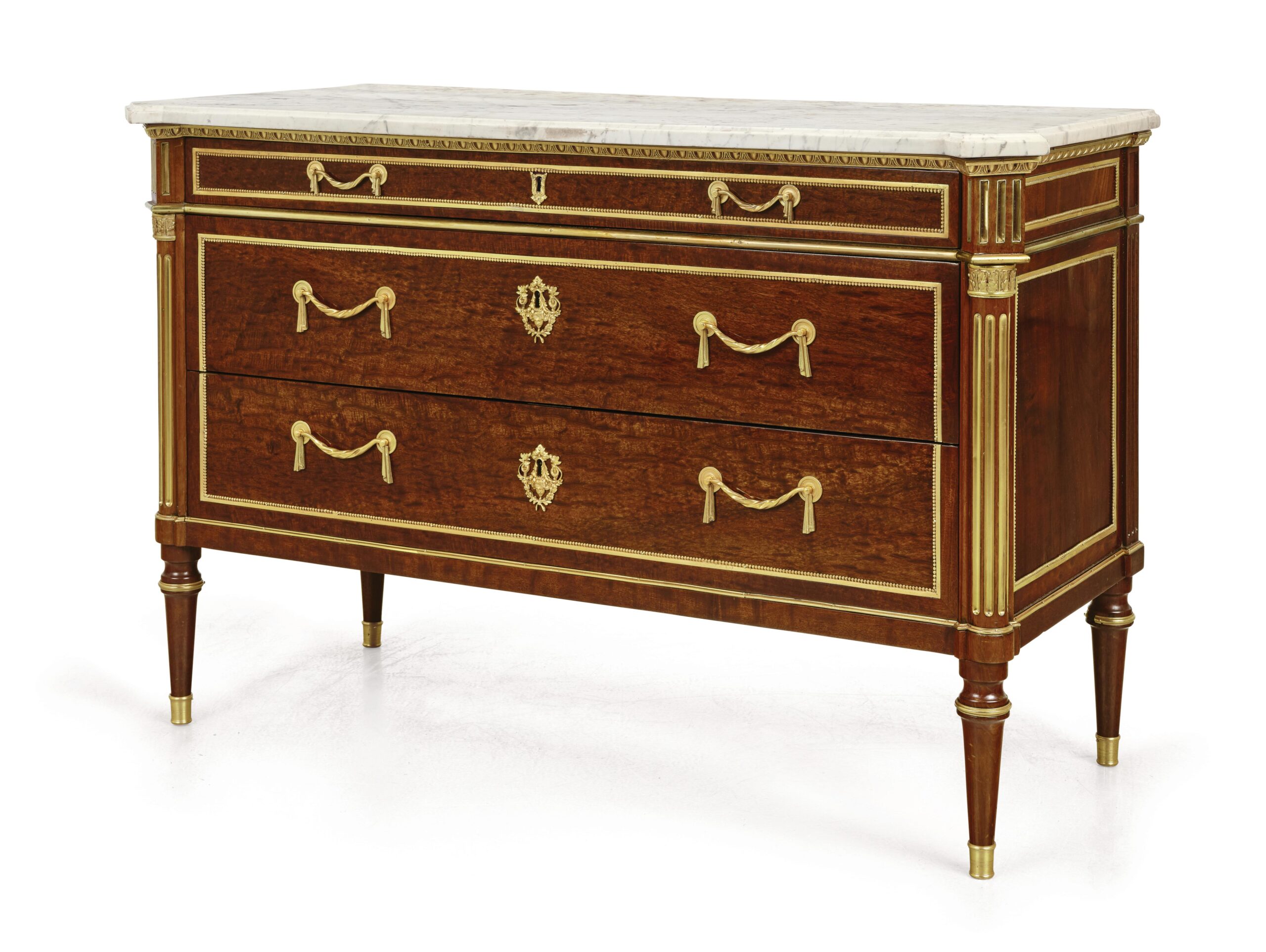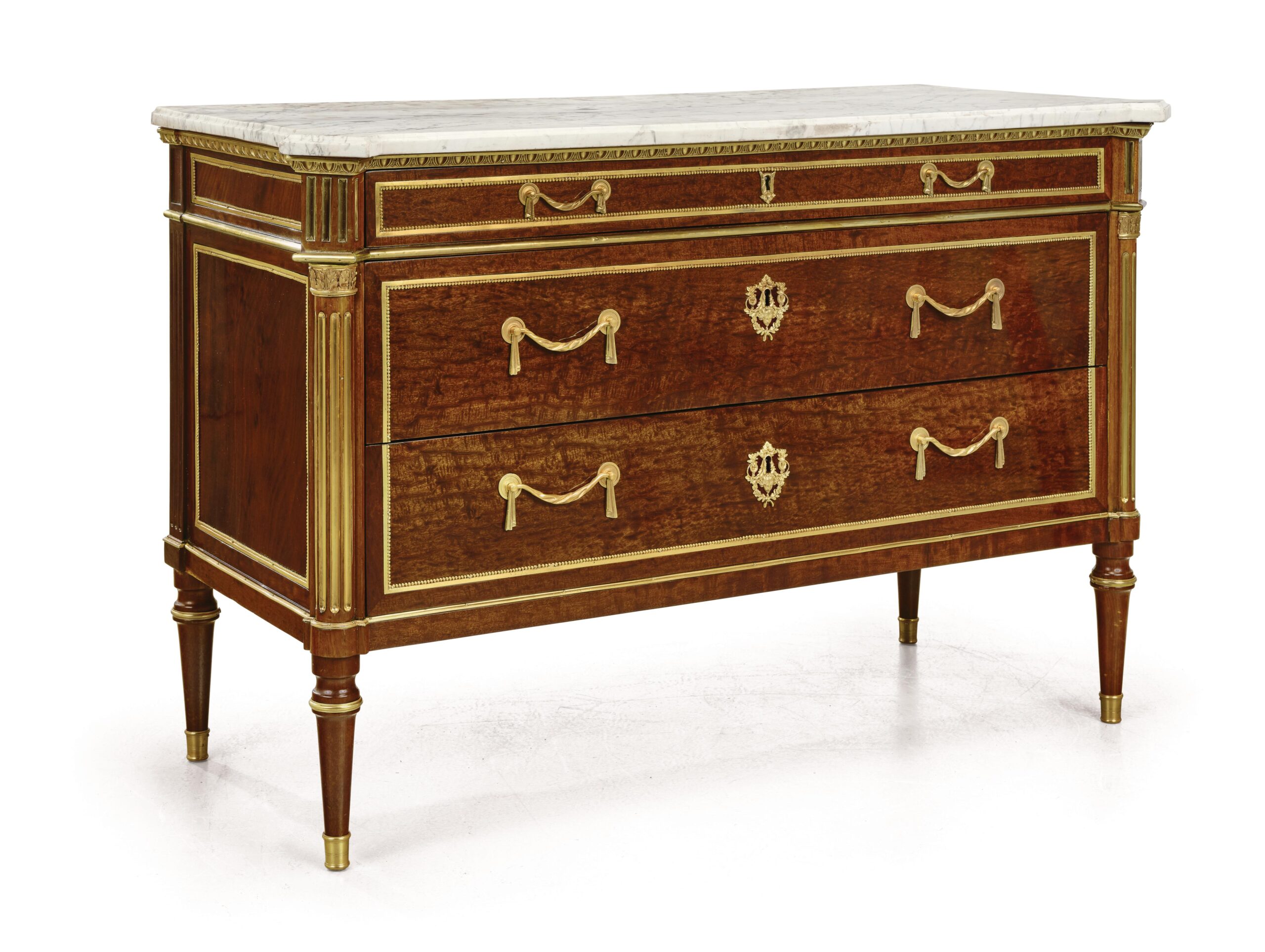Chest of drawers and sideboards
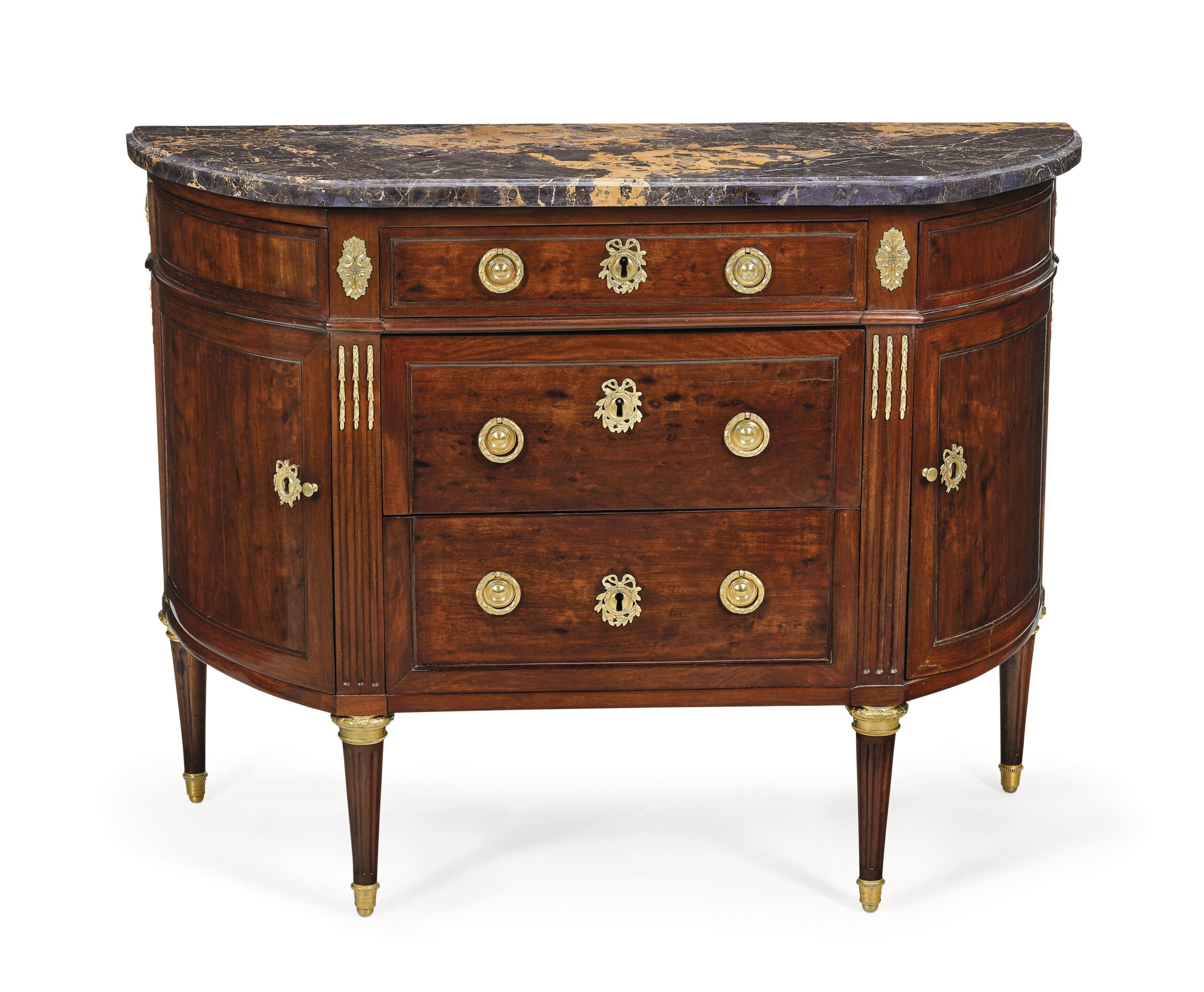
 €8,500.00
€8,500.00by the ebenist Conrad Mauter (1742 – 1810), in so-called “Demi Lune” form, Louis XVI period around 1780, partly mahogany wood and mahogany veneered, polished in traditional craftsmanship, fluted studs, conical feet, 3 drawers, 2 side doors, chiselled gilt bronze fittings, stamped C. MAUTER (master from 1777), profiled marble top, 85 x 114 x 44 cm,
expertly restored condition.
Conrad Mauter’s clients included the Comte de Artois, brother of King Louis XVI, and himself, later known as King
Charles X.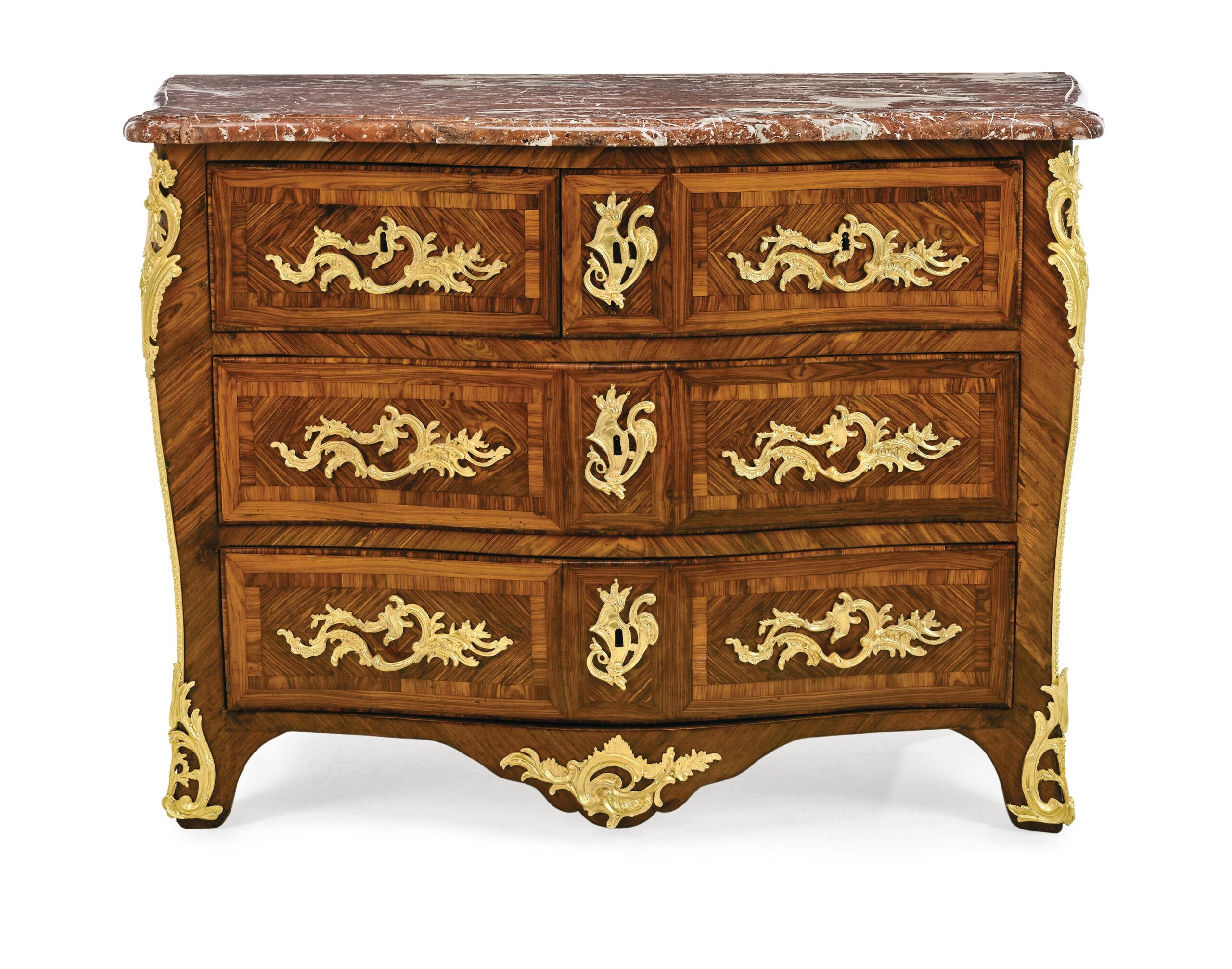
 Sold
SoldSo-called. “Tombeau”, Louis XV period, mid 18th century, various softwoods and hardwoods, rosewood veneer, field-marked, polished in traditional polished in traditional craftsmanship, 4 drawers, chiselled gilt bronze mounts, stamped D GENTY (Denis Genty,
Master from 1754), moulded marble top, approx. 82.5 x 114 x 59 cm, beautiful professionally restored condition.
 Sold
SoldElegant French Louis XVI-style salon commode
By ébéniste E. Brunet, last quarter of the 19th century
Oak carcass, veneered in mahogany
High-quality marquetry in precious woods
Traditional finish: hand-polished, recessed areas matte
Two drawers “sans traverse” (without crossbar)
Finely chased, gilt-bronze mounts
Profiled marble top
Lock stamped E. BRUNET PARIS
Dimensions: 93 × 94 × 51.5 cm
Professionally restored condition
E. Brunet: cabinetmaker from a renowned dynasty, Gold Medal 1889, specialist in Louis XVI museum reproductions

 Sold
SoldFrance, late 19th century
After a model by Jean-François Oeben (18th century)
Salon commode / Commode à Portes
Combination of hardwoods and softwoods
Marquetry in partly dyed exotic woods
Traditional French-polish finish
- Dimensions: approx. 103 × 100 × 47 cm
Subject to CITES regulations
Elegant French craftsmanship inspired by Oeben

 €14,000.00
€14,000.00Pair of Transition style salon sideboards
Parisian manufacture François Daide, mid-20th century
After a model by Jean Henri Riesener
Matt, finely chased gilt-bronze mounts
Each with three doors and two drawers
Profiled marble tops
Stamped “FD” on the rear upright
Dimensions: 58 × 168 × 98 cm
Subject to species protection (ASB)
Traditional French family-owned manufacturer (founded 1742)

 Sold
SoldIn the Louis XV style, late 19th/early 20th century, finely crafted, curved and cambered oak body, veneered with satinwood and rosewood and richly marquetry with various precious woods in the form of flowers and leaves.
oak body, veneered with satinwood and rosewood and richly inlaid with various precious woods in the form of flowers and leaves, two drawers, polished, chased gilt bronze fittings, multi-profiled marble top, 85 x 126 x 50 cm, in beautiful, expertly restored condition. Sold
SoldIn the Louis XV style, modelled on 18th century examples 19th century models, curved hardwood and softwood hardwood and softwood body, primed in black and painted in in the form of landscape scenes and figures in lacquer technique decorated with raised lacquer, two drawers on the front, gilded bronze fittings, moulded marble top, 84.5 x 120 x 49.5 cm, beautiful professionally restored condition.
 €8,000.00
€8,000.00Period: Transition (Louis XV – Louis XVI), France, c. 1770
Maker: François Reizell (Master 1764, Paris)
Structure: Oak carcass veneered with amaranth and rosewood
Decoration: Geometric marquetry in precious woods
Finish: Hand-polished (French polish)
Drawers: Two drawers “sans traverse”
Mounts: Finely chased gilt-bronze ormolu
Top: Moulded Campan Rubané marble
Mark: Stamped “F. REIZELL”
Dimensions: 88 × 114 × 52 cm
Condition: Excellent, expertly restored
Note: Subject to CITES (ASB)
Provenance: Worked for Prince de Condé; employed Josef Baumhauer
 €7,000.00
€7,000.00Jean Popsel (master since 1755), Paris
Transition period, circa 1770
Oak corpus veneered with rosewood and amaranth
Geometric marquetry with various precious woods
Three drawers, gilt bronze mounts
Profiled marble top (probably later)
Stamped “J. POPSEL” and master’s mark
Dimensions: 89 × 132 × 65 cm
Professionally restored condition
 Sold
Soldso-called. Tombeau, by the ebenist Jean-Charles Ellaume, (master from 1754), mid 18th century, curved softwood body, rosewood veneered, field-marked, polished in traditional craftsmanship, five drawers, double curved drawer fronts, “En Arbalete” rich finely chased and gilded bronze fittings, prof. Marble top, stamped J C ELLAUME and master’s mark, 88.5 x 133 x 56 cm, in beautiful, expertly restored condition. (MIN)
Subject to species protection (ASB)
 Sold
SoldEpoch Louis XV, by the ebenist Louis Moreau, (master from 1764) three-sided curved oak body, veneered with amaranth and rosewood and richly ornamented with various, partly dyed precious woods, floral and in the form of musical instruments and books, polished in traditional craftsmanship, two drawers, finely chased gilt bronze fittings, double profiled marble top, (Breche de Alep) 89 x 125 x 52 cm, beautiful professionally restored condition.
Subject to species protection (ASB)
 Sold
SoldSalon chest of drawers in transitional style, by the Parisian firm Maison Krieger, late 19th century, oak body, veneered with mahogany and satinwood mahogany and satinwood, finely chased gilded bronze bronze mounts, hallmark, MON KRIEGER AMEUBLEMENT PARIS, moulded marble top marble top, 79 x 91 x 46 cm, beautiful professionally restored condition.
 Sold
Sold2nd half 18th century various hardwoods and softwoods, rosewood veneer, polished using traditional craftsmanship,
field-shaped marquetry, curved front with four drawers, gilt bronze fittings, stamped BOICHOD, (Pierre
Boichod, master from 1769) original, moulded marble top, 83 x 79 x 52.5 cm, in beautiful, expertly restored condition. Pierre Boichod also worked for the great masters such as Jean Fracois Oeben and Pierre II Migeon. €4,500.00
€4,500.00in transitional style, high-quality work from the first third of the 20th century, hardwood body, veneered with rosewood and finely marquetried with various precious woods in the shape of a field and in the form of circular ornaments, frosted, richly decorated with gilded chiselled bronze fittings, three drawers, marble top, 94 x 116 x 55 cm, restored condition.
 €3,500.00
€3,500.00France, late 19th century
Louis XV-style salon commode
Three-sided serpentine oak body
Veneered with kingwood and rosewood, fine panel marquetry
Traditional French polish finish
Two drawers
Gilt-bronze fittings
Shaped Rouge de Languedoc marble top
Dimensions: approx. 89 × 145 × 55 cm
Excellent, professionally restored condition
Subject to CITES regulations
 €16,000.00
€16,000.00Louis XVI commode, Paris circa 1780
Masterpiece by Joseph Stöckel (1743–1802)
Oak and mahogany, partly veneered, polished finish
Original marble top and gilt-bronze mounts
Stamped J. STOCKEL with master’s mark
Historically significant cabinetmaker to the royal court
Restored condition, CITES-regulated
Chest of Drawers and Sideboards – French Elegance from the 18th and 19th Century
Explore our exclusive collection of antique chests of drawers and sideboards, showcasing the craftsmanship and style of French artisans from the 18th and 19th centuries. Each piece in our collection is a unique masterpiece, rich in history and adorned with exquisite details that bring timeless elegance to your interiors.
Our Collection
Our antique chests of drawers feature stunning marquetry, intricate carvings, and luxurious materials such as mahogany, oak, and rosewood. Many pieces are enhanced with gilded bronze accents and finely polished marble tops, perfectly capturing the opulence and sophistication of a bygone era.
Our sideboards combine functionality with decorative appeal, elevating your living spaces. Whether in the Louis XV, Louis XVI, or Empire style, each piece tells its own story and stands as a testament to French craftsmanship.
Why Choose Antique Chests of Drawers and Sideboards?
- Timeless Beauty: These pieces seamlessly fit into both classic and contemporary interiors.
- Sustainability: Buying antiques is environmentally friendly and preserves cultural heritage.
- Uniqueness: Each piece is a one-of-a-kind work of art with a fascinating history.
Be Inspired
Whether you’re looking for a statement piece for your living room or a functional item with charm, our collection has the perfect piece for you. Visit our showroom in Vienna or explore our selection online.
You can find a more detailed description of the various styles in our BLOG.






